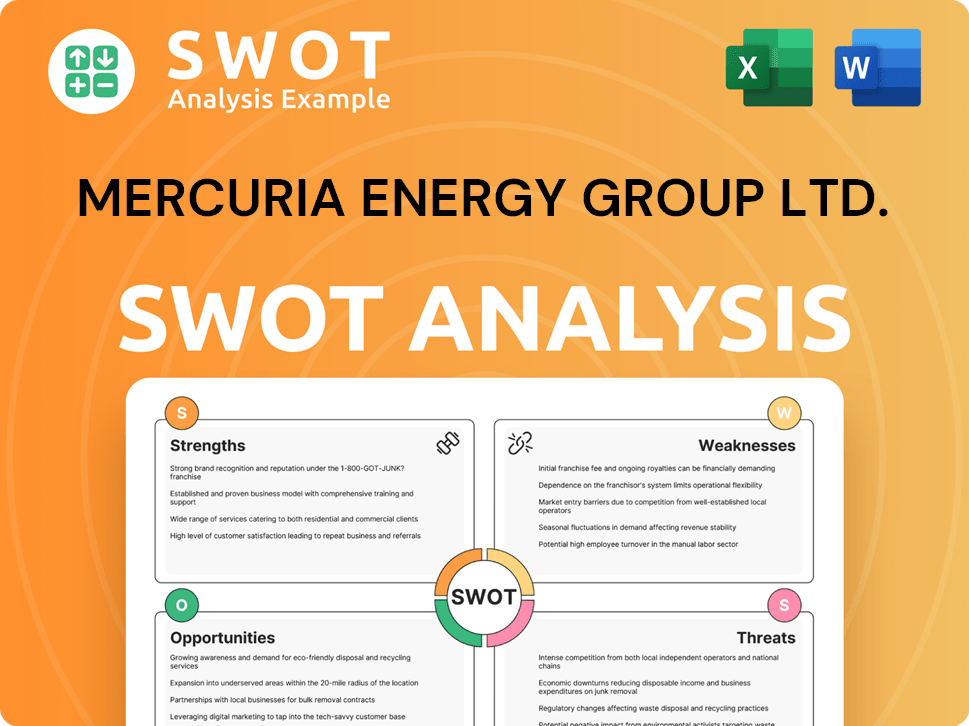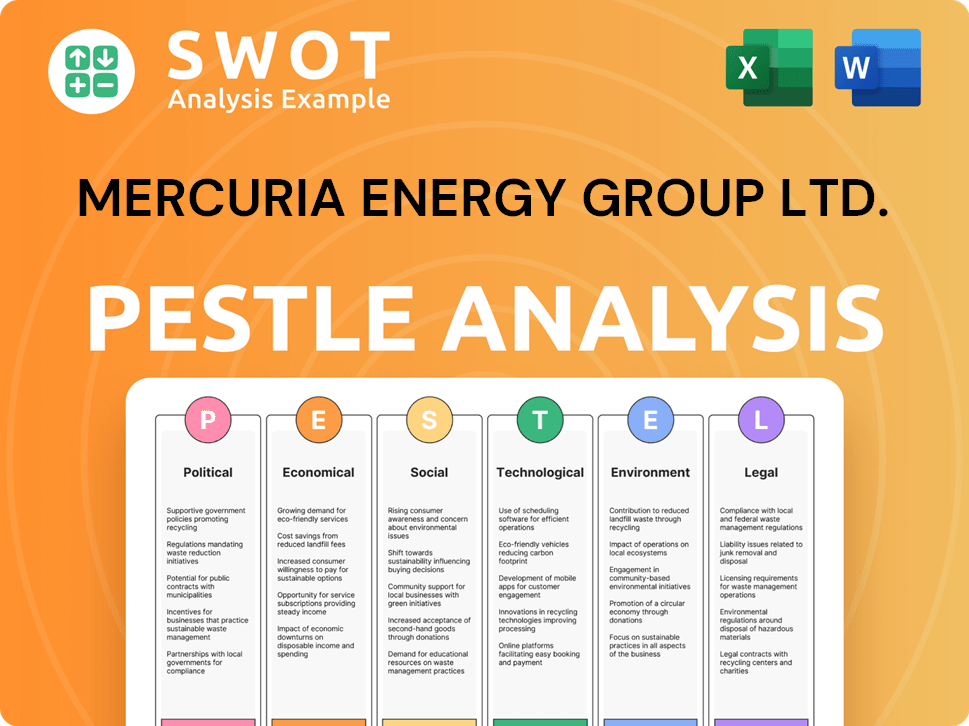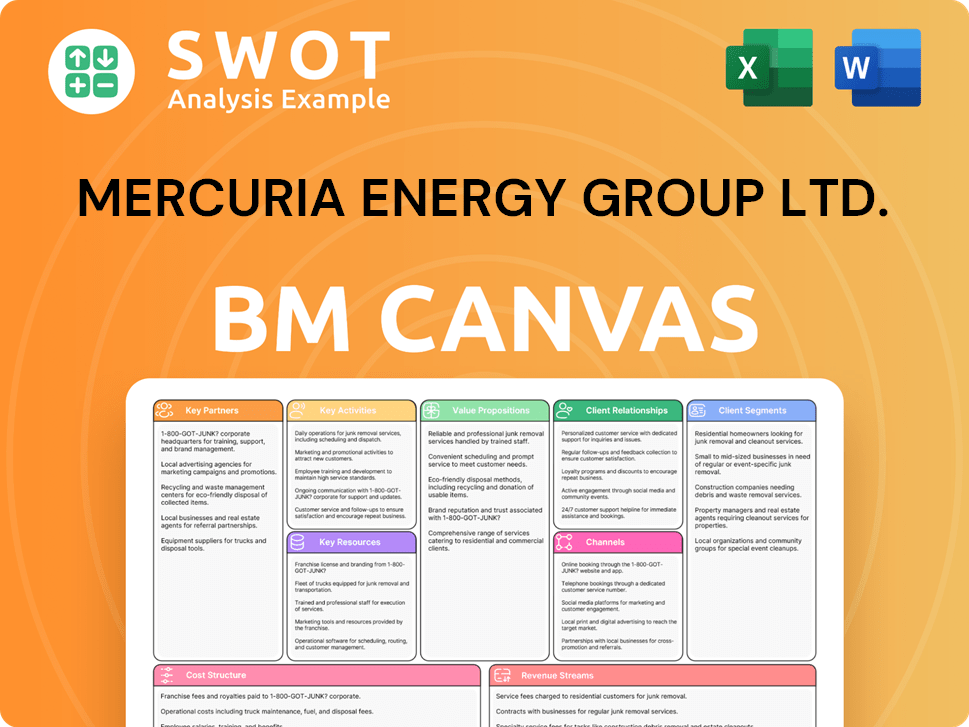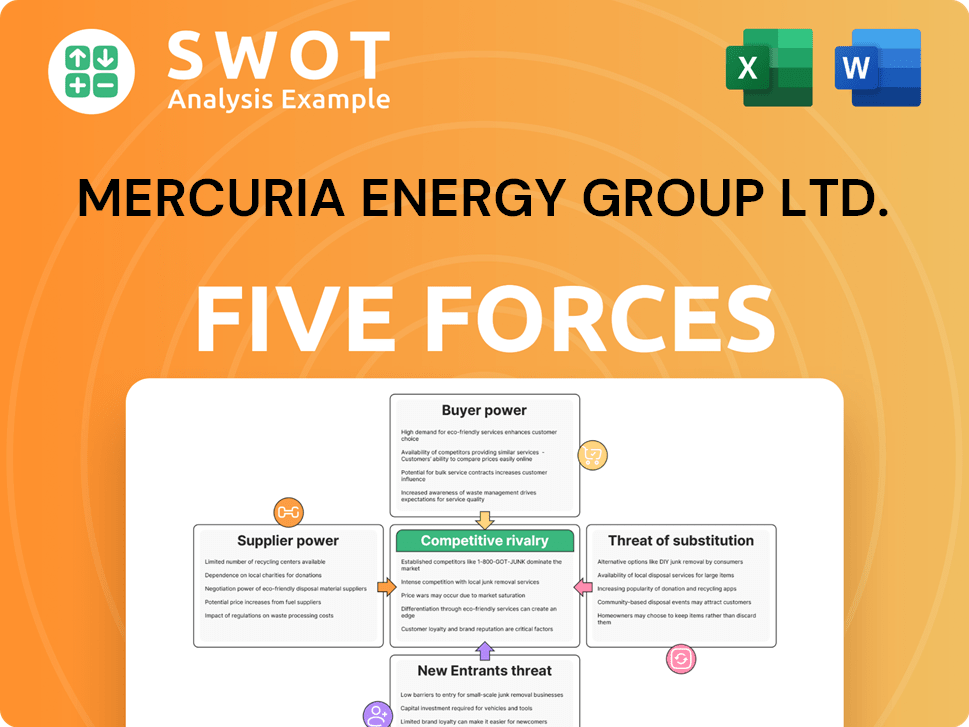Mercuria Energy Group Ltd. Bundle
Who Really Controls Mercuria Energy Group Ltd.?
Unraveling the ownership of a global energy giant like Mercuria Energy Group Ltd. is crucial for understanding its strategic moves and market influence. The company's ownership structure dictates its direction, impacting everything from investment decisions to risk management. Knowing who owns Mercuria offers a window into its future in the dynamic energy sector.

Mercuria Energy Group Ltd.'s ownership structure is a complex web, making it essential to identify its key players and their influence. This analysis explores the evolution of Mercuria Energy Group Ltd. SWOT Analysis, from its founding by Marco Dunand and Daniel Jaeggi to the involvement of major shareholders and any shifts in the company's structure. Understanding the Mercuria ownership landscape offers valuable insights into its operational strategies and overall market position, including the roles of Mercuria executives and the company's legal structure.
Who Founded Mercuria Energy Group Ltd.?
The origins of Mercuria Energy Group Ltd trace back to 2004, when it was founded by Marco Dunand and Daniel Jaeggi. Both founders brought extensive experience from their previous roles at Phibro, a division of Salomon Brothers, and later at the trading arm of Sempra Energy. Their combined expertise in energy trading was crucial in shaping Mercuria's initial strategy and its subsequent growth trajectory.
At its inception, Mercuria was a privately held entity. While the precise equity split between Dunand and Jaeggi at the outset is not publicly available, it's understood that they held significant control. This structure allowed for focused decision-making and strategic agility in the dynamic commodity markets. The founders' vision for a globally focused energy trading firm was directly reflected in their consolidated control.
Unlike many startups, Mercuria's early growth was primarily fueled by its trading activities and retained earnings rather than external investments. There were no widely reported instances of early ownership disputes or buyouts that significantly altered the initial control structure. Early agreements likely focused on solidifying the founders' long-term commitment and ensuring alignment with the company's aggressive growth objectives.
Marco Dunand and Daniel Jaeggi, the founders of Mercuria Energy Group Ltd, had prior experience at Phibro and Sempra Energy. This background was instrumental in establishing Mercuria's initial trading strategies.
Dunand and Jaeggi held substantial control of Mercuria from its founding. The exact equity split is not publicly disclosed, but the founders maintained significant influence.
Mercuria's early growth was largely funded through its trading profits. This approach differed from many startups that rely on external funding.
The founders' control allowed for swift decision-making. This was crucial for capitalizing on opportunities in the fast-paced commodity markets.
Early agreements likely focused on solidifying the founders' long-term commitment. This ensured alignment with Mercuria's aggressive growth objectives.
Mercuria remained a privately held company in its early stages. This allowed for greater control and strategic flexibility.
Understanding the initial Mercuria ownership structure provides context for the company's evolution. For further insights into the competitive landscape, consider exploring the Competitors Landscape of Mercuria Energy Group Ltd.. As of late 2024, Mercuria continues to be a major player in the energy trading sector, with its structure reflecting its early foundations.
Mercuria Energy Group Ltd. SWOT Analysis
- Complete SWOT Breakdown
- Fully Customizable
- Editable in Excel & Word
- Professional Formatting
- Investor-Ready Format

How Has Mercuria Energy Group Ltd.’s Ownership Changed Over Time?
The ownership of Mercuria Energy Group Ltd. has evolved strategically since its inception, remaining primarily private. A significant shift occurred in 2014 when ChemChina acquired a 12% stake, marking a major external equity infusion. This move aimed to strengthen Mercuria's presence in Asian markets and enhance access to resources.
In 2016, Mercuria further diversified its ownership by selling an additional 12% stake to Chinese investors, including China Investment Corporation (CIC) and an investment vehicle of the China Everbright Group. This brought the total Chinese ownership to 24%. These investments were strategic alliances intended to bolster Mercuria's global reach. As of early 2024, the founders, Marco Dunand and Daniel Jaeggi, along with other employees, hold the majority stake, estimated at around 76%.
| Year | Event | Impact on Ownership |
|---|---|---|
| 2014 | ChemChina acquired a 12% stake | Increased external investment and strategic partnership |
| 2016 | Additional 12% stake sold to Chinese investors (CIC, Everbright) | Further diversification of ownership and strengthened Asian market focus |
| Early 2024 | Founders and employees hold approximately 76% | Maintained control by founding leadership and key personnel |
Mercuria's ownership structure involves a mix of private and strategic investors.
- ChemChina and other Chinese entities hold a significant minority stake.
- The founders and employees retain a majority ownership.
- These ownership dynamics influence the company's strategic direction and market focus.
- Understanding the Mercuria ownership structure is crucial for assessing its strategic moves.
Mercuria Energy Group Ltd. PESTLE Analysis
- Covers All 6 PESTLE Categories
- No Research Needed – Save Hours of Work
- Built by Experts, Trusted by Consultants
- Instant Download, Ready to Use
- 100% Editable, Fully Customizable

Who Sits on Mercuria Energy Group Ltd.’s Board?
Regarding the board of directors of Mercuria Energy Group Ltd, as a privately held entity, details are not as readily available as those of publicly traded companies. However, it's understood that the founders, Marco Dunand and Daniel Jaeggi, hold significant influence. They likely occupy key positions on the board due to their majority Mercuria ownership. Their continued substantial equity stake ensures their significant control over strategic decisions.
Representatives from major Chinese stakeholders, such as ChemChina and the consortium including China Investment Corporation (CIC), are expected to have board representation. This is commensurate with their significant 24% ownership stake. These board seats typically provide them with a voice in governance and strategic planning. The specific voting rights, such as veto powers or shareholder agreements, are not publicly disclosed. The decision-making process likely involves close collaboration between the founding management and major institutional investors, aiming for consensus on critical strategic initiatives. For more insights, you can explore the Growth Strategy of Mercuria Energy Group Ltd.
| Board Member | Role | Ownership Influence |
|---|---|---|
| Marco Dunand | Likely Key Board Position | Significant, due to Founder status and majority ownership |
| Daniel Jaeggi | Likely Key Board Position | Significant, due to Founder status and majority ownership |
| ChemChina Representative | Board Member | Influential, representing a major shareholder |
| CIC Consortium Representative | Board Member | Influential, representing a major shareholder |
The Mercuria company structure is designed to facilitate close collaboration between founding management and major institutional investors. This structure likely prioritizes consensus on strategic initiatives. The private nature of the company typically means a one-share-one-vote structure, although specific arrangements for key investors are often detailed in private shareholder agreements. There have been no widely reported proxy battles or activist investor campaigns, which is common for a privately held company with a concentrated ownership base. The key personnel and Mercuria executives work within this framework to guide the company's strategic direction.
The founders, Marco Dunand and Daniel Jaeggi, hold significant influence due to their majority ownership.
- Major Chinese stakeholders, like ChemChina and CIC, have board representation.
- The decision-making process emphasizes collaboration.
- Specific voting arrangements are detailed in private shareholder agreements.
- No public proxy battles or activist campaigns have been reported.
Mercuria Energy Group Ltd. Business Model Canvas
- Complete 9-Block Business Model Canvas
- Effortlessly Communicate Your Business Strategy
- Investor-Ready BMC Format
- 100% Editable and Customizable
- Clear and Structured Layout

What Recent Changes Have Shaped Mercuria Energy Group Ltd.’s Ownership Landscape?
Over the past few years, the ownership of Mercuria Energy Group Ltd has demonstrated relative stability. While there have been no major public offerings or share buybacks, the company has strategically invested in areas such as renewable energy and energy transition assets. These moves indicate a long-term strategy aligned with global energy trends, including investments in battery storage and sustainable fuels.
The commodity trading industry has seen trends of increased institutional ownership. However, Mercuria ownership has largely remained private, with significant founder and employee ownership. This suggests a preference for maintaining control and flexibility. Strategic investments by Chinese entities continue to play a role, supporting Mercuria's commodity flows. There have been no public statements about an imminent public listing or significant shifts in the core ownership structure.
| Ownership Aspect | Details | Recent Trends |
|---|---|---|
| Shareholder Base | Predominantly private, with significant founder and employee ownership. | Stability in core ownership, with no major changes reported. |
| Strategic Investments | Focus on renewable energy, battery storage, and sustainable fuels. | Expansion into energy transition assets, reflecting long-term strategy. |
| Chinese Investments | Involvement of Chinese entities. | Continued support for commodity flows and Asian market ties. |
To learn more about the company's background, you can read the Brief History of Mercuria Energy Group Ltd.
Mercuria's ownership structure has remained relatively consistent, with no significant public changes. The company has focused on strategic investments in renewable energy. This suggests a long-term vision and commitment to its current ownership model. The emphasis is on leveraging existing trading expertise.
Investments in renewable energy and energy transition assets highlight Mercuria's strategic direction. This includes ventures into battery storage and sustainable fuels. These investments align with global energy trends. They also support the company's long-term growth strategy.
Mercuria continues to maintain its private status, with significant founder and employee ownership. This provides the company with greater control and flexibility. The private structure allows Mercuria to focus on long-term strategies. It also allows it to avoid the pressures of public markets.
Strategic investments by Chinese entities continue to foster deeper ties. These ties are particularly important in Asian markets. They also support Mercuria's commodity flows. This demonstrates a strong international presence. It also highlights the company's ability to navigate global markets.
Mercuria Energy Group Ltd. Porter's Five Forces Analysis
- Covers All 5 Competitive Forces in Detail
- Structured for Consultants, Students, and Founders
- 100% Editable in Microsoft Word & Excel
- Instant Digital Download – Use Immediately
- Compatible with Mac & PC – Fully Unlocked

Related Blogs
- What are Mission Vision & Core Values of Mercuria Energy Group Ltd. Company?
- What is Competitive Landscape of Mercuria Energy Group Ltd. Company?
- What is Growth Strategy and Future Prospects of Mercuria Energy Group Ltd. Company?
- How Does Mercuria Energy Group Ltd. Company Work?
- What is Sales and Marketing Strategy of Mercuria Energy Group Ltd. Company?
- What is Brief History of Mercuria Energy Group Ltd. Company?
- What is Customer Demographics and Target Market of Mercuria Energy Group Ltd. Company?
Disclaimer
All information, articles, and product details provided on this website are for general informational and educational purposes only. We do not claim any ownership over, nor do we intend to infringe upon, any trademarks, copyrights, logos, brand names, or other intellectual property mentioned or depicted on this site. Such intellectual property remains the property of its respective owners, and any references here are made solely for identification or informational purposes, without implying any affiliation, endorsement, or partnership.
We make no representations or warranties, express or implied, regarding the accuracy, completeness, or suitability of any content or products presented. Nothing on this website should be construed as legal, tax, investment, financial, medical, or other professional advice. In addition, no part of this site—including articles or product references—constitutes a solicitation, recommendation, endorsement, advertisement, or offer to buy or sell any securities, franchises, or other financial instruments, particularly in jurisdictions where such activity would be unlawful.
All content is of a general nature and may not address the specific circumstances of any individual or entity. It is not a substitute for professional advice or services. Any actions you take based on the information provided here are strictly at your own risk. You accept full responsibility for any decisions or outcomes arising from your use of this website and agree to release us from any liability in connection with your use of, or reliance upon, the content or products found herein.